Old-fashioned cultured buttermilk is tangy, mildly sour, and helps give baked goods like pancakes, biscuits, and cake a moist, airy texture. There’s a reason a lot of recipes call for it! Here’s how to make homemade buttermilk + 5 easy substitutes!
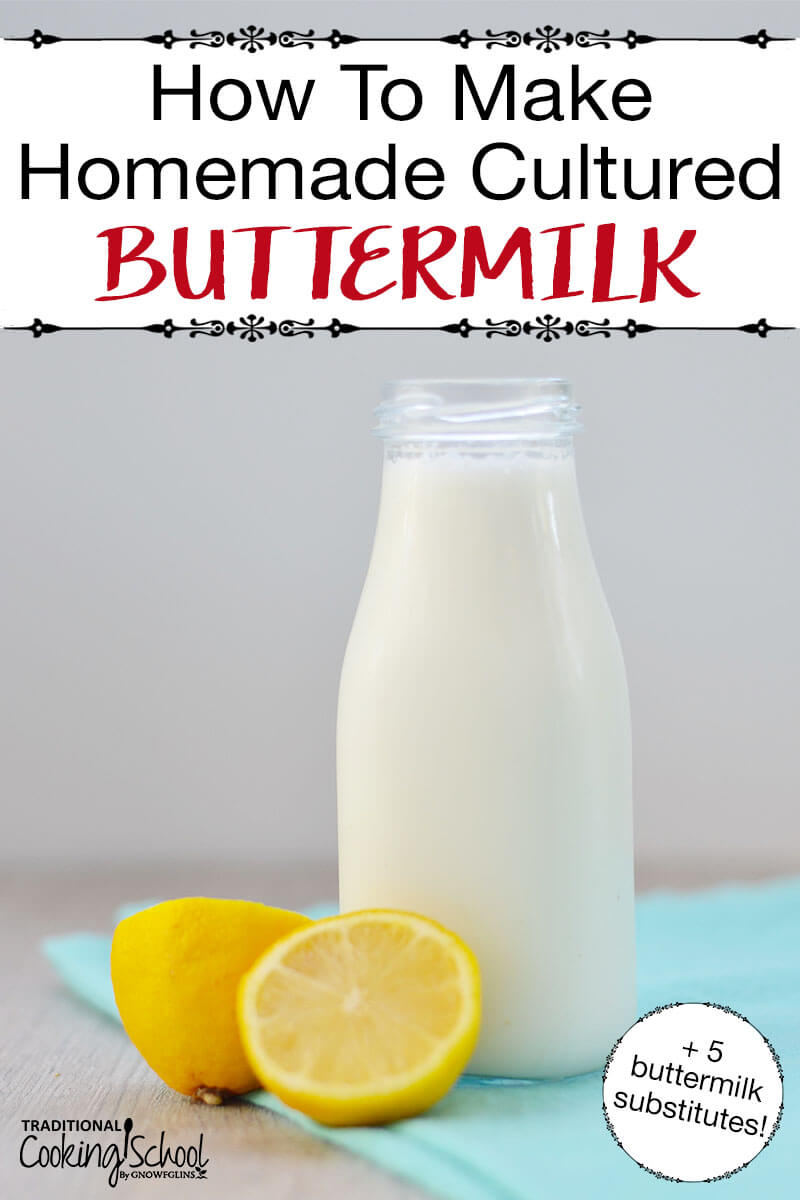
Buttermilk is an ingredient called for in many recipes, especially baked goods, but may not be something you always have on hand.
Thankfully, it’s quick and easy to make buttermilk and buttermilk substitutes. In today’s post you’ll learn two simple methods for making it at home.
Before we dive into the how-to, let’s discuss the what and why of buttermilk.
What Is Buttermilk?
Original buttermilk is the liquid that remains after butter is churned. (Here’s how to make cultured butter!)
This old-fashioned kind has a tangy, mildly-sour taste but is not quite as thick as the commercial buttermilk that can be purchased today.
Nowadays, buttermilk is not generally thought of as the remaining liquid from churning butter, but a beverage produced by culturing milk with live beneficial bacteria such as Streptococcus lactis or Lactococcus lactis.
Buttermilk is not the same as sour milk, although the two can often be used interchangeably in recipes.
Why Use Buttermilk?
Since buttermilk is acidic in nature, it adds a tender, airy texture to most baked goods as well as a great crumb. It’s known to keep baked goods moist and help them rise, while its tangy taste creates a distinctive flavor.
Known to tenderize meat, you’ll often find it in recipes for fried chicken and beef marinades.
Because of these unique qualities, it is best to use buttermilk (or a substitute) when called for in a recipe, since plain milk will not yield the same results.
Buttermilk is also thought to improve digestion, and many people drink it plain or add it to smoothies for that reason.
Recipes Using Buttermilk
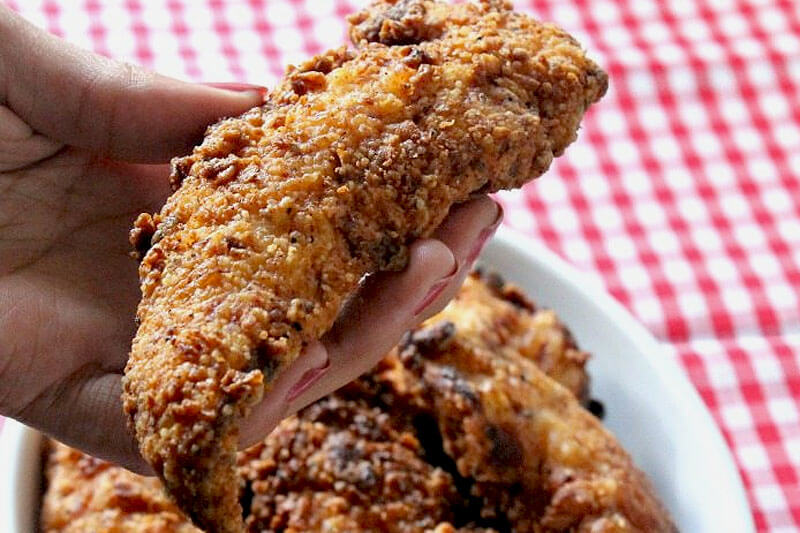
Image courtesy of Pioneering Today.
There are many recipes using buttermilk, most of which are baked goods such as biscuits, pancakes, sweet cakes (such as chocolate cake) and breads. You’ll also find it in savory dishes such as recipes for fried chicken, salad dressing, and dips.
It’s also great for pre-soaking oats for better digestion.
Here are some delicious recipes to try, in addition to your old favorites:
- Gluten-Free Soaked Irish Soda Bread
- Boston Brown Bread
- Bacon Skillet Cornbread
- Soaked Biscuits
- Sprouted English Scones With Probiotic Devonshire Cream
- Soaked Apple Cider Donuts
- Cranberry Blue Cheese Log
- Fermented Ranch Dressing
- Fried Chicken Strips
- Crispy Old-Fashioned Fried Chicken
- Chocolate Cake
How To Make 5 Quick & Easy Buttermilk Substitutes
As mentioned above, plain milk is not a good substitute for buttermilk in a recipe. If you are not able to make or use cultured buttermilk, the following substitutes are your best options.
The simplest substitute is 1 tablespoon of lemon juice or vinegar combined with 1 cup of plain milk. This works because the acids in the lemon and vinegar act to sour the milk.
Buttermilk Substitute (Homemade Sour Milk) Recipe

Pour 1 tablespoon of lemon juice or vinegar (apple cider or white vinegar work well) into the bottom of a glass measuring cup.
Add milk until it reaches the 1-cup line. Stir to combine.
Let mixture sit at room temperature for about 10 minutes.
After 10 minutes, milk should have curdled slightly. Stir to combine.
It is now ready to use!
Dairy-Free Buttermilk Substitute
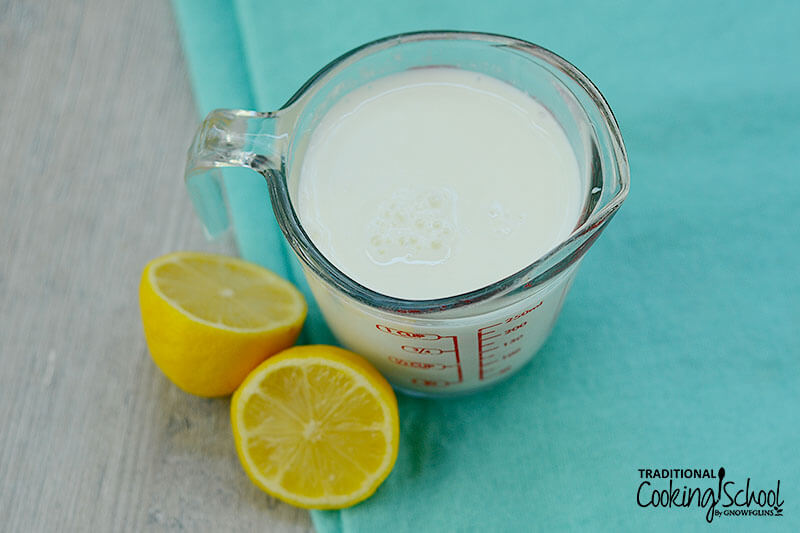
To make a dairy-free buttermilk substitute, combine 1 tablespoon of lemon juice or vinegar with 1 cup of coconut milk or almond milk. It is not quite the same as when made with dairy milk, but works well enough to use in most baked goods.
Store in the fridge and use within 1 week.
Other Substitutes
Thin 3/4 cup plain Greek yogurt with 1/4 cup water or milk.
Use unsweetened, unflavored milk kefir as a direct substitute. (Learn how to make milk kefir!) This works well for muffins and such, but would not be a good choice for things like Irish Soda Bread (see recipe above).
Thin 3/4 cup sour cream with 1/4 cup water or milk.
Homemade Cultured Buttermilk
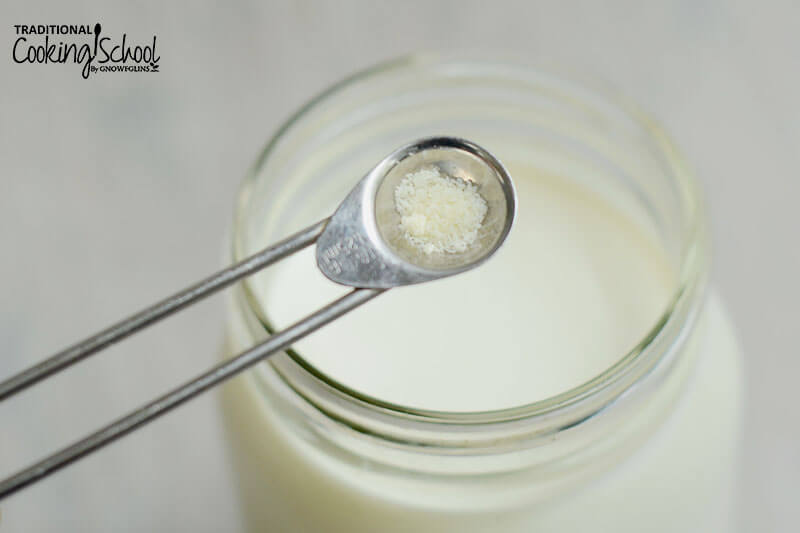
The quick and easy substitutes I just described are wonderful in many recipes, but not as nutritious (or delicious) as true cultured buttermilk.
Cultured buttermilk can be consumed as a beverage all on its own, whereas substitutes cannot.
Besides being a great addition to baked goods, it is also excellent in smoothies.
Make homemade cultured buttermilk by adding a starter culture to plain whole milk. The three most common starters are:
- powdered cultured buttermilk starter
- mesophilic starter culture (can also be used to make cheese)
- store-bought cultured buttermilk
My favorite way to make cultured buttermilk is by using a powdered buttermilk starter. I will demonstrate this method below, but will also include instructions for the other methods.
Note: Cultured buttermilk can be made with regular store-bought milk or raw milk. However, if you are using a powdered starter, you will need to take an extra step to prepare the raw milk (see notes below). All you need is whole milk and a powdered buttermilk starter.
A powdered buttermilk starter, such as this one, makes it super simple to make homemade buttermilk teeming with beneficial bacteria.
The important thing to know about this starter is that you will need to activate it first. However, once it’s activated, it can be propagated indefinitely.
This means you can use part of the first batch to culture more milk, resulting in an endless supply of buttermilk!
Ready? Let’s Get In The Kitchen!
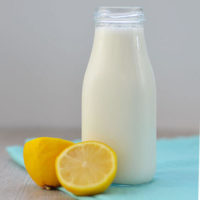
Homemade Cultured Buttermilk
Old-fashioned cultured buttermilk is tangy, mildly sour, and helps give baked goods like pancakes, biscuits, and cake a moist, airy texture.
Ingredients
- 1 packet cultured buttermilk starter or 1/8 teaspoon mesophilic starter, or 1 cup store-bought buttermilk
- 1 quart raw and/or whole milk if using store-bought buttermilk as the starter, only use 3 cups of regular milk instead of 1 quart; see Notes if using raw milk
Instructions
To make your first batch of buttermilk:
-
Mix together starter and milk in a quart-sized glass jar or other similar container.
-
Cover jar with a towel or coffee filter, securing it with a rubber band, and let it sit in a warm spot for 24 hours or until set (up to 48 hours).
-
Once set, cover jar with a tight lid, then refrigerate for at least 6 hours.
-
The buttermilk is now ready to use! Be sure to reserve 1/4 cup of it to culture the next batch, if you want to make more.
To make more buttermilk using the first batch as a starter:
-
Combine approximately 1/4 cup of buttermilk with 4 cups of milk.
-
Stir to combine.
-
Cover with a coffee filter or cloth and secure with a rubber band.
-
Leave in a warm spot to culture for 12 to 24 hours, putting it in the refrigerator once set.
-
Repeat this cycle each week to have a constant supply of buttermilk on hand.
Recipe Notes
Special Instructions For Using Raw Milk:
If using raw milk, you will need to sterilize the milk before creating the initial buttermilk culture. You will not need to do this for subsequent batches that are made from the initial batch, but it must be done when activating the starter.
I know this may seem unusual and counter-intuitive, especially when we so often tout the benefits of raw dairy, however there is a good reason for it.
You see, raw milk is full of beneficial live bacteria. This will compete with bacteria in the cultured buttermilk powder and compromise the quality and taste of the buttermilk.
To stop this from happening, heat the raw milk to 160 degrees Fahrenheit and let it cool to room temperature before adding the starter powder.
Again, this is only for the first batch of buttermilk (the starter). Subsequent batches of buttermilk can be made with raw milk if desired.
If your buttermilk starts to taste off or is not culturing properly, it may be because the organisms in the raw milk are preventing it from culturing successfully. You would want to pasteurize the milk again at that point.
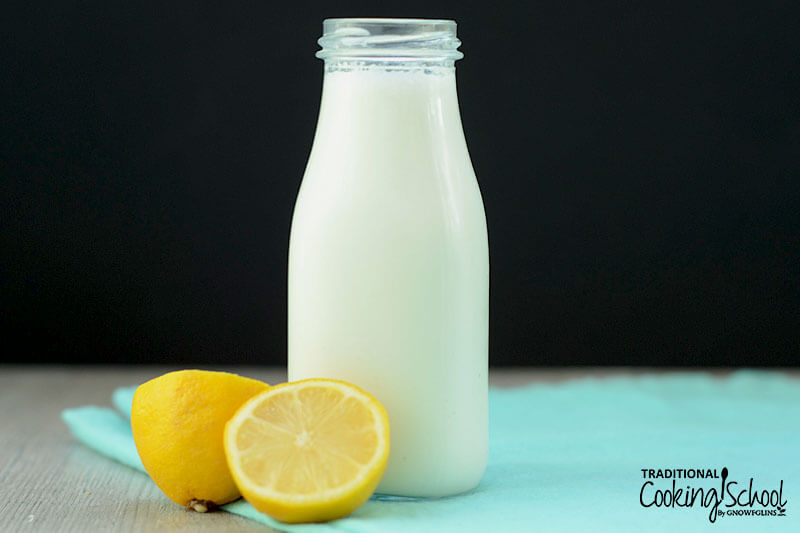
Learn more about cultured dairy and its benefits in the Cultured Dairy & Basic Cheese eCourse!
Do you like to make your own cultured dairy? What recipes have you tried
Other Cultured Dairy Recipes
- How To Make Cultured Butter
- Compound Butter {Butter Gets Dressed Up!}
- Homemade Raw Cheddar Cheese
- 4 Easy Raw Cheese Recipes
- Easy Sour Cream (with free video!)
- What To Do With Soured Cream?
- Homemade Cottage Cheese From Raw Goat Milk
- Cultured Cream Cheese (+5 flavor options!)
- How to Make Raw Milk Mascarpone: Soft, Probiotic Cheese
- Middle Eastern Kefir Cheese Balls {with free video!}
...without giving up the foods you love or spending all day in the kitchen!

2 free books:
Eat God's Way
Ditch the Standard American Diet, get healthier & happier, and save money on groceries...
We only recommend products and services we wholeheartedly endorse. This post may contain special links through which we earn a small commission if you make a purchase (though your price is the same).


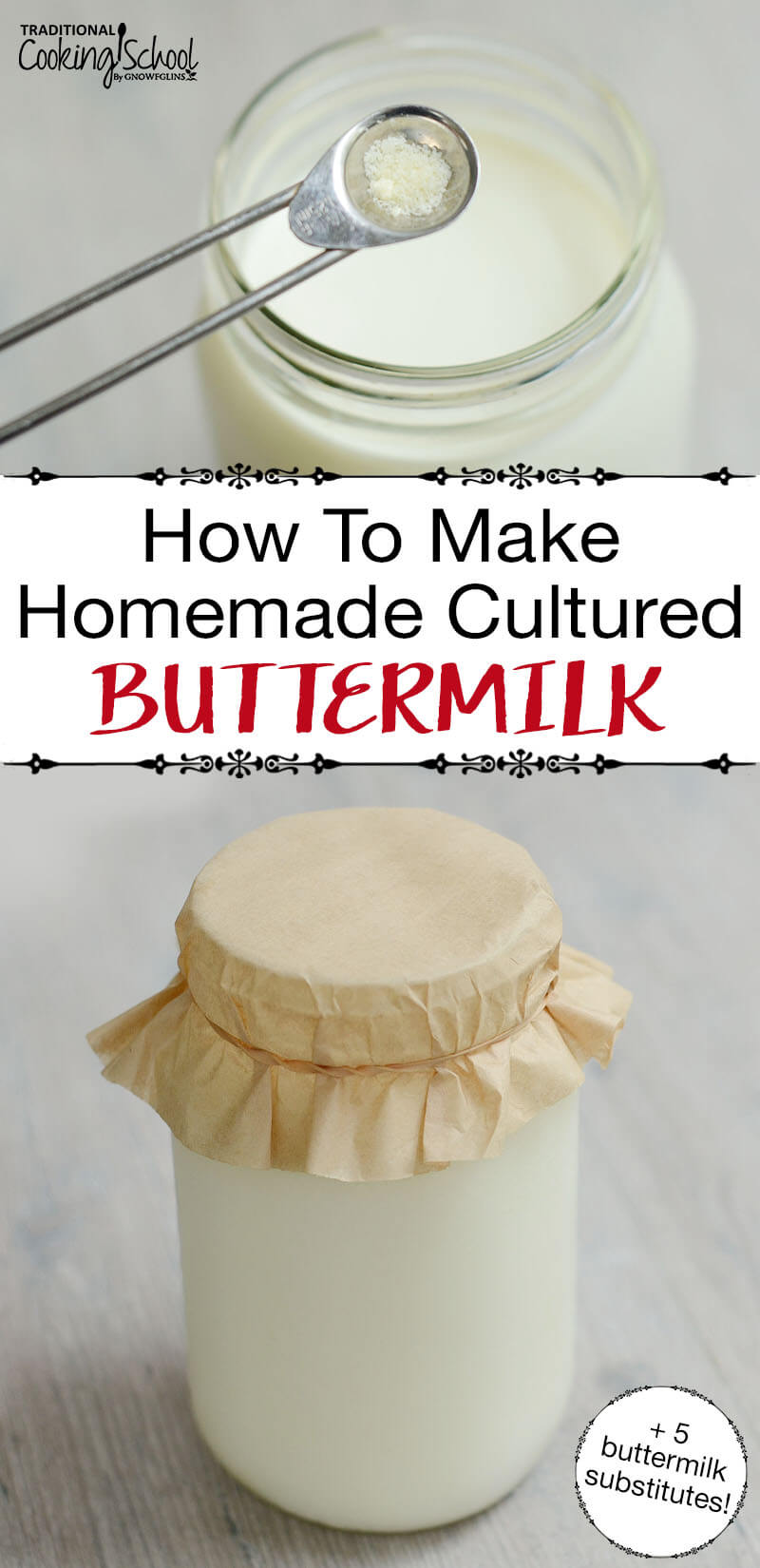
How long is a batch of buttermilk good for? Does it only last a week or get better with time? ? Also my dairy sells buttermilk, so I can just use that and go to step 2, yes? Thank you, this is so helpful!
Can you use a quart of heavy cream instead of milk? After the cream is done culturing you can beat it to make cultured butter. One quart of cream+starter should yield about a pound of butter and about a quart of buttermilk.
I can’t use my cultured buttermilk (made from store buttermilk for starter) in biscuits. Complete flop. The texture of the buttermilk that I cultured is like pancake batter. Any suggestions?
Hi, can I use this buttermilk in yeast rolls? The lady above me said she tried it with biscuits and it didn’t work. I am very excited about this because I live a long way from the grocery and I constantly use buttermilk. If this works it will be a life-changer for me. Thank you and God bless you real big???????
I would like to understand the history of buttermilk- I have made buttermilk by making butter with my students…it’s the leftover liquid that separates out from the butterfat– and it isn’t sour.
Why has buttermilk come to be synonymous with cultured/soured milk? Was the buttermilk from making butter originally left to sour? I’m interested in knowing the history and also to not use packaged starters but to know the traditional ways to work with raw dairy. Thank you for any info!